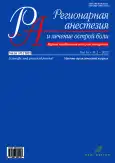Intravenous lidocaine infusion in children
- 作者: Felker E.Y.1, Fataliev M.S.1, Kolosov A.O.1, Ibragimov R.N.1, Tantseva T.V.1, Ivanova L.V.1, Gromov P.V.2, Zabolotsky D.V.1,3, Koryachkin V.A.1
-
隶属关系:
- Saint-Petersburg State Pediatric Medical University
- Clinical Hospital “RZD-Medicine”
- National Medical Research Center for Pediatric Traumatology and Orthopedics named after G.I. Turner
- 期: 卷 16, 编号 2 (2022)
- 页面: 129-138
- 栏目: Original articles
- URL: https://journals.rcsi.science/1993-6508/article/view/109500
- DOI: https://doi.org/10.17816/1993-6508-2022-16-1-129-138
- ID: 109500
如何引用文章
详细
BACKGROUND: The problem of adequate analgesia in the early postoperative period is not relevant at present, both in our country and abroad because >50% of children experience pain after surgical interventions despite the ongoing therapy. Inadequate “ideal” method for assessing the pain syndrome severity, age restrictions with several drugs, and difficult communication with young children, as well as drug selection, lead to inadequate detection in pediatric practice.
AIM: This study aimed to evaluate the effectiveness and safety of intravenous infusion of lidocaine in the early postoperative period in children operated on the abdominal cavity organs.
MATERIALS AND METHODS: This study included 119 children who were randomized into 3 groups, in which intravenous lidocaine infusion, prolonged epidural blockade, or systemic fentanyl analgesia were used for pain relief after abdominal surgery. Hemodynamic parameters, respiratory system, pain intensity, resolution time of intestinal paresis, cortisol, glucose and lidocaine levels in blood plasma, and complications were monitored and compared intergroup.
RESULTS: Lidocaine infusion had no effects on the hemodynamics and respiratory system in children. Cortisol level was markedly decreased through the day to baseline (320±65 nmol/l). Early recovery of peristalsis corresponded to 23±3.75 h postoperatively. The pain syndrome intensity during the observation period did not exceed 2 points. The maximum level of free lidocaine in blood plasma was 2.81±1.31 µg/ml, and the time spent in the intensive care unit (ICU) was 48±10 h.
CONCLUSION: Intravenous infusion of lidocaine after abdominal surgery in children is a safe method that provides effective pain relief, restores peristalsis early, and reduces the length of ICU stay.
关键词
作者简介
Evgeny Felker
Saint-Petersburg State Pediatric Medical University
编辑信件的主要联系方式.
Email: felkeru@gmail.com
ORCID iD: 0000-0002-7780-8871
SPIN 代码: 9244-0361
Scopus 作者 ID: 57223179573
Researcher ID: GOH-0546-2022
MD, Cand. Sci. (Med.)
俄罗斯联邦, St. PetersburgMaxim Fataliev
Saint-Petersburg State Pediatric Medical University
Email: fataliev.maxim@mail.ru
ORCID iD: 0000-0002-4599-9730
俄罗斯联邦, St. Petersburg
Andrey Kolosov
Saint-Petersburg State Pediatric Medical University
Email: And-85@yandex.ru
ORCID iD: 0000-0001-8737-0802
俄罗斯联邦, St. Petersburg
Rustam Ibragimov
Saint-Petersburg State Pediatric Medical University
Email: Rustyibr@gmail.com
ORCID iD: 0000-0002-5009-1938
俄罗斯联邦, St. Petersburg
Tatiana Tantseva
Saint-Petersburg State Pediatric Medical University
Email: felkeru@gmail.com
ORCID iD: 0000-0001-5441-7870
俄罗斯联邦, St. Petersburg
Liliya Ivanova
Saint-Petersburg State Pediatric Medical University
Email: liliva@rambler.ru
ORCID iD: 0000-0002-3682-3995
MD, Cand. Sci. (Med.)
俄罗斯联邦, St. PetersburgPetr Gromov
Clinical Hospital “RZD-Medicine”
Email: gromovpv@rwmed.ru
ORCID iD: 0000-0001-9132-6388
MD, Cand. Sci. (Med.)
俄罗斯联邦, St. PetersburgDmitry Zabolotsky
Saint-Petersburg State Pediatric Medical University; National Medical Research Center for Pediatric Traumatology and Orthopedics named after G.I. Turner
Email: zdv4330303@gmail.com
ORCID iD: 0000-0002-6127-0798
SPIN 代码: 6726-2571
MD, Dr. Sci. (Med.), professor
俄罗斯联邦, St. Petersburg; St. PetersburgVictor Koryachkin
Saint-Petersburg State Pediatric Medical University
Email: vakoryachkin@mail.ru
ORCID iD: 0000-0002-3400-8989
SPIN 代码: 6101-0578
MD, Dr. Sci. (Med.), Professor
俄罗斯联邦, St. Petersburg参考
- Ovechkin AM, Yavorovskii AG. Bezopioidnaya analgeziya v khirurgicheskoi praktike: rukovodstvo dlya vrachei. Moscow: GEOTAR-Media; 2019. 240 p. (In Russ).
- Makhlouf MM, Garibay ER, Jenkins BN, et al. Postoperative pain: factors and tools to improve pain management in children. Pain Manag. 2019;9(4):389–397. doi: 10.2217/pmt-2018-0079
- Rabbitts JA, Fisher E, Rosenbloom BN, Palermo TM. Prevalence and Predictors of Chronic Postsurgical Pain in Children: A Systematic Review and Meta-Analysis. J Pain. 2017;18(6):605–614. doi: 10.1016/j.jpain.2017.03.007
- Zabolotskii DV. Prodlennaya mestnaya anesteziya u detei s ortopedicheskoi patologiei [dissertation]. Saint Petersburg: SpbGPMU; 2015. (In Russ).
- Zabolotskiy DV, Koryachkin VA. Child and regional anesthesia – What for? Where? And how? Regional Anesthesia and Acute Pain Management. 2016;10(4):243–253. (In Russ). doi: 10.18821/1993-6508-2016-10-4-243-253
- Zabolotski DV, Koriachkin VA, Ulrikh GE. Postoperative Analgesia in Children. Are There Any Methods Available Today? Regional Anesthesia and Acute Pain Management. 2017;11(2):64–72. (In Russ). doi: 10.18821/1993-6508-2017-11-2-64-72
- Ovechkin AM, Becker AA. Intravenous Lidocaine Infusion as a Perspective Component of Multimodal Analgesia, Which Affects on Early Postoperative Outcome. Regional Anesthesia and Acute Pain Management. 2017;11(2):73–83. (In Russ). doi: 10.18821/1993-6508-2017-11-2-73-83
- Koscielniak-Merak B, Batko I, Kobylarz K, et al. Intravenous, Perioperatively Administered Lidocaine Regulates Serum Pain Modulators’ Concentrations in Children Undergoing Spinal Surgery. Pain Med. 2020;21(7):1464–1473. doi: 10.1093/pm/pnz212
- Weibel S, Jelting Y, Pace NL, et al. Continuous intravenous perioperative lidocaine infusion for postoperative pain and recovery in adults. Cochrane Database Syst Rev. 2018;6:CD009642. doi: 10.1002/14651858.CD009642.pub3
- Weinberg L. Pharmacokinetics and pharmacodynamics of lignocaine: A review. World Journal of Anesthesiology. 2015;4(2):17. doi: 10.5313/wja.v4.i2.17
- Downes H, Loehning RW. Local anesthetic contracture and relaxation of airway smooth muscle. Anesthesiology. 1977;47(5):430–436. doi: 10.1097/00000542-197711000-00008
- Clivio S, Putzu A, Tramer MR. Intravenous Lidocaine for the Prevention of Cough: Systematic Review and Meta-analysis of Randomized Controlled Trials. Anesth Analg. 2019;129(5):1249–1255. doi: 10.1213/ANE.0000000000003699
- Koryachkin VA. Neiroaksial’nye blokady. 2-e izd. Saint Petersburg: ELBI-Spb; 2017. (In Russ).
- Boeckxstaens GE, de Jonge WJ. Neuroimmune mechanisms in postoperative ileus. Gut. 2009;58(9):1300-1311. doi: 10.1136/gut.2008.169250
- Wongyingsinn M, Baldini G, Charlebois P, et al. Intravenous lidocaine versus thoracic epidural analgesia: a randomized controlled trial in patients undergoing laparoscopic colorectal surgery using an enhanced recovery program. Reg Anesth Pain Med. 2011;36(3):241–248. doi: 10.1097/AAP.0b013e31820d4362
- Aliev MM, Dekhqonboev AA, Yuldashev RZ. Advantages of abdominal ultrasound in the management of infants with necrotizing enterocolitis. Pediatr Surg Int. 2017;33(2):213–216. doi: 10.1007/s00383-016-4017-8
- Weibel S, Rucker G, Eberhart LH, et al. Drugs for preventing postoperative nausea and vomiting in adults after general anaesthesia: a network meta-analysis. Cochrane Database Syst Rev. 2020;10:CD012859. doi: 10.1002/14651858.CD012859.pub2
- van der Wal SE, van den Heuvel SA, Radema SA, et al. The in vitro mechanisms and in vivo efficacy of intravenous lidocaine on the neuroinflammatory response in acute and chronic pain. Eur J Pain. 2016;20(5):655–674. doi: 10.1002/ejp.794
- Soto G, Naranjo Gonzalez M, Calero F. Intravenous lidocaine infusion. Rev Esp Anestesiol Reanim (Engl Ed). 2018;65(5):269–274. doi: 10.1016/j.redar.2018.01.004
补充文件










